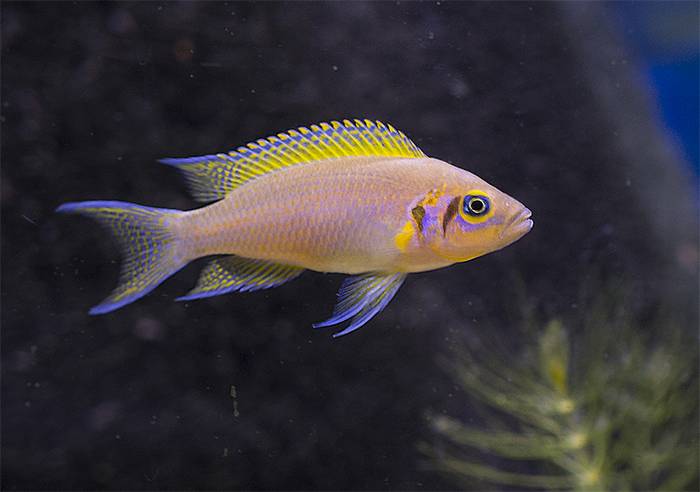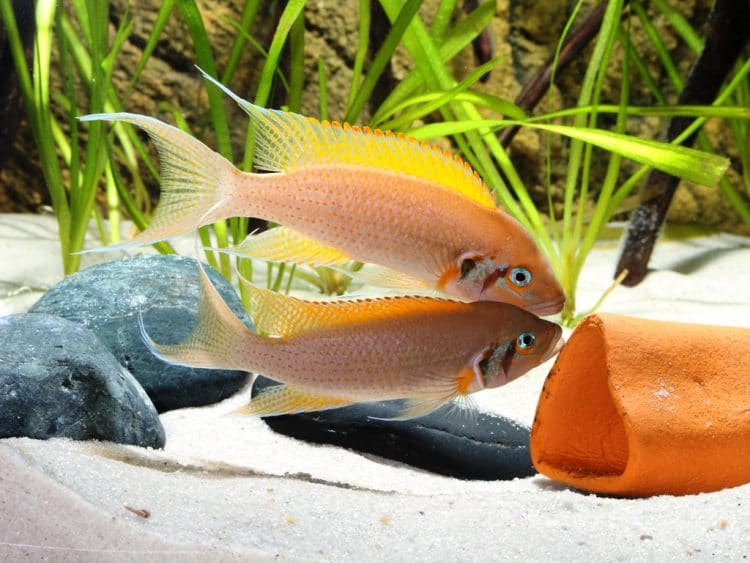
When I first started keeping tropical fish as a young child, I often marveled at a fish many stores identified as the brichardi cichlid. The fish may not have been colored with the spectacular coloration of the Malawi Peacocks or the Victorian Haps, but what it lacked in flashy color the brichardi made up for in grace. Since those early days, Ive kept many different fish, but for some reason I never fulfilled that childhood dream. About a decade later, I started a job that allowed me to keep a small tank in my laboratory. As I was pouring through my aquatic library, searching for the perfect lab partner, I came across an article about the newest reorganization of the brichardi species complex. I was instantly attracted to the fish the author referred to as Neolamprologus pulcher Daffodil. The next day, I started surfing the internet for more information on the fish. To my astonishment, a fellow GCAS member was offering Neolamprologus pulcher Daffodil II fry for sale. Finally, I would be able to keep one of the elegant members of the brichardi species complex.
Before I go into the specifics of my personal experience with the Daffodil II, I would like to share some background information on the Daffodil II. First, I would like to explain the curious nomenclature attached to this fish. Traditionally, African cichlid color morphs are identified by attaching the part of the lake that the fish are found, after the scientific name. According to my sources, these fish were given the name Daffodil II, so that the importer would not have to divulge the exact location in Lake Tanganyika where these fish flock. Although the original Daffodil is considered a color morph of Neolamprologus pulcher, since the Daffodil II was named for commercial reasons, I believe either Neolamprologus pulcher Daffodil II or Neolamprologus sp. Daffodil II are acceptable names until further scientific studies are conducted on this fish.
It seems as though when dealing with African cichlids, hobbyists deal with extremes. They either keep open water cichlids, or cichlids that never leave the security of the rocks. However, when dealing with Neolamprologus pulcher, the hobbyist is dealing with a fish that embraces both extremes. These fish travel in large flocks in the open waters of Lake Tanganyika, feeding on the drifting plankton. However, once a pair of fish are ready to spawn, they vehemently defend the secure cave they choose to raise their young. This marked distinction from the majority of Tanganyikans is directly tied to these fishs family, breeding behavior. N. pulcher, and all of its color morphs, exhibit very interesting breeding behavior called stepped breeding. This means that once the parents raise a clutch of fry and are prepared to spawn again, the juveniles from the prior clutch stay behind to help raise their younger siblings. The large flocks of N. pulcher are actually large family groups. In these flocks, the breeding pair can be found in the center of the group, and the youngest juveniles will be left to reside near the exterior of the flock. When one member of the breeding pair passes on, the next dominant member of the flock takes its place.
The Daffodil II reaches an adult length of up to 4-5 inches. Its caudal fin is a lyre-tail shape, and there is a thin, ice blue fringe along all of its fins. The bodys coloration is an amalgamation of yellow and bluish-purple spots on a tan body with yellow highlights at the base of the pectoral fin and a splash of blue on the operculum. All fish considered part of the brichardi species complex have two black bars located on the operculum, which according to their orientation, differentiates one species from another. The Daffodil II has two parallel, vertical bars both crescent shape. The male fish is slightly longer and a lot thicker than the female, and he will have a slightly enlarged forehead (no rival for other male Tanganyikans such as C. frontosa).

I initially purchased seven fry for my 29-gallon tank from fellow GCAS member Laura Boyle. The tank had been up and running for about a week before I added the small school of fry. A UGF powered with two Aquaclear 1000 powerheads filtered the water through about 30 pounds of CaribSea Authentic rift lake substrate. The aquarium was decorated with various pieces of slate, lace, and local lime rock stacked over top of a perforated, PVC base. Weekly 25% water changes kept Ammonia and nitrite at 0, and Nitrate at <25 ppm. The tanks pH was maintained at 8.3 and dH at about 12.
About a week after the initial school of fry was added to the aquarium, Laura offered me another four fish to ensure I got at least one pair out of the group. The fry ranged from a mere ˝ to a whopping 1 ˝ . The larger fish quickly began establishing territories all over the tank while the younger siblings seemingly tagged along with their elder brothers and sisters. After about 3-4 weeks about three-fourths of the fry were already developing at least some of their adult coloration. Unfortunately, the next time I performed a water change, I filled the tank a little too high (up to the light shield) and Monday morning I came in to find all of the fry suffocated. Despite this tragedy, I was able to acquire the wild-caught parents of the fry, and finally I would be able to spawn these beautiful fish.
When I first picked up the parents, Laura made the comment that the female was looking a little chubby, and that she may be egg-laden. I didnt worry too much about her observation, because I thought that the stress of relocating the fish would override the will to spawn. I acclimated the fish (Laura also threw in a fry from previous spawn), and within an hour the three had selected the deepest cave as their headquarters. I fed them a mixture of staple, Spirulina, and Brine Shrimp flake food supplemented with a variety Hikaris Bio-Pure frozen foods. I fed the fish small portions several times per day, and even then I would find the adults snacking on the live ramshorn snails that shared the tank with them. The next Friday, I hooked up my Python to perform a water change, and the next time I looked at its progress I found about half the water gone. I quickly stopped the siphon, filled the tank back up, packed up my supplies, and left for the weekend. Monday morning I noticed that whenever I fed the tank, only two of the fish would come out and eat. As the day progressed, I started to notice that only two fish were visible at any time, all the time. By about four in the afternoon, my curiosity had peaked, and as soon as I pressed my nose against the glass, I saw one tiny fry that was not yet free-swimming. Using a flashlight, I was able to find about four or five.
Once the fish were free-swimming, I fed the newborn fish microworms, until they were about a week old when I began offering finely crushed flake, and frozen daphnia. At this point I noticed more eggs. Laura had mentioned these fish were prolific, but despite this advice I convinced myself these were snail eggs. The eggs were gone the next morning, and I noticed a couple more tiny fry hugging the rocks. After a few days I realized that there were a total of five babies, one short to qualify for BAP points. I was certain these fish had some sort of BAP vendetta against me.
The next Monday, I performed a water change in the morning, and by three in the afternoon, I was amazed to find the parents laying a third clutch of eggs. The female laid the eggs along the inside of a piece of PVC, and the male fertilized them, as she laid. Once the final egg was laid, I immediately added Nox-Ich to the water (using one drop per gallon daily), and watched as the two adults and eldest sibling took turns fanning the eggs. Almost exactly 48 hours after they laid the eggs, the 42 tan eggs began to hatch. Once these fry hatched, they slipped out of sight for about 48 hours until they became free-swimming. Although the parents were very watchful of their offspring, they did not actively herd the young, like other cichlids. Instead, all of the fish hovered around a cave where everyone knew to flock, if anyone walked by the tank.
I had been delivering the microworms to the two prior broods with a pipette. However, now that there were about twenty-five fry that were getting very curious and gutsy, this was not necessary. Instead I scooped up a small, grape-sized portion of microworms onto a toothbrush, and swished them free in the aquarium. This size portion would keep the fry occupied all day long. As I mentioned before, these fish feed on plankton in Lake Tanganyika, and this became even more evident, whenever I fed the young microworms. The young would find a strong current to swim against and let the drifting worms come to them. This feeding behavior is oddly reminiscent of the feeding behavior exhibited by the saltwater anthias species. Another interesting comparison between these two groups of fish is that both have lyre-tailed caudal fins and both flock in very large schools. Evolutionary biologists call this phenomenon, whereby two geographically isolated species develop similar characteristics, convergent evolution.
Although I finally got my BAP points, the story ends sadly, as both parents died after they raised this final brood. The male mysteriously disappeared after about a week, and I watched the female take her last breath about three weeks later. This may sound hokey (or maybe familiar), but I felt so bad about all of the misfortunes I put this magnificent species through, that I promised my young lab partners a 75 gallon tank in my fish room. Although my experience with these fish was riddled with obstacles, their grace and superb behavior truly fulfilled that long lost childhood dream, and Im sure even the most experienced hobbyist will draw just as much pleasure from breeding them.
Leave a Reply